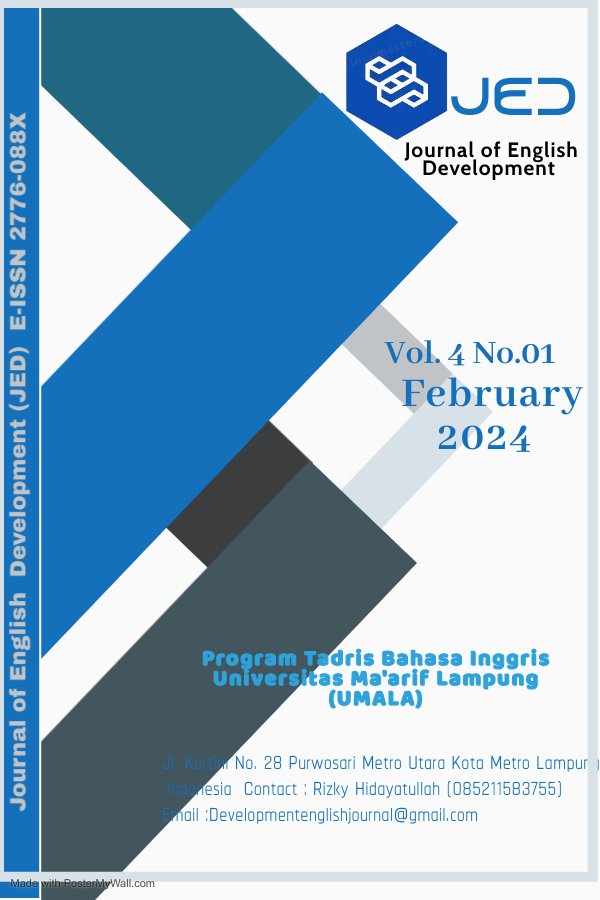Promoting Young Learners’ English Vocabulary Acquisition Using Picture Word Inductive Model Focusing On Indonesian Culture
English
DOI:
https://doi.org/10.25217/jed.v4i01.4269Keywords:
Young Learners’, English Vocabulary Acquisition, Picture Word Inductive Model, Indonesian CultureAbstract
This study aims to analyze the utilization of the Picture word inductive model focusing on Indonesian culture to improve the English vocabulary acquisition ability of grade 5 students at Ban Erawan school, Thailand. The method used in this study was a quasi-experimental design type involving two groups, namely the experimental group and the control group. The researcher collected quantitative data by distributing pre-test and post-test to 30 students in the experimental and control groups. The researcher analyzed the data obtained from the post-test scores of the experimental group and the control group using the Mann-Whitney test on the SPSS application. From the results of the quantitative analysis, it is known that there is a difference in vocabulary acquisition between the experimental group and the control group with the significant level p<0,05 (p=.000). This suggest that Picture Word Inductive model focusing on Indonesian culture was proven to improve students' English vocabulary acquisition. In addition, students gave positive responses during data collection. The selection of learning media that is interesting and favored by students can facilitate the learning process of students and increase student motivation.
References
REFERENCES
Barani, G., Mazandarani, O., & Rezaie, S. H. S. (2010). The effect of application of picture into picture audio- visual aids on vocabulary learning of young Iranian ELF learners. Procedia - Social and Behavioral Sciences, 2(2). https://doi.org/10.1016/j.sbspro.2010.03.874
Calhoun, E. F. (1999). Teaching beginning reading and writing with the Picture Word Inductive Model. In Association of Supervision and Curriculum Development.
Gu, C., & Lornklang, T. (2021). The Use of Picture-word Inductive Model and Readers’ Theater to Improve Chinese EFL Learners’ Vocabulary Learning Achievement. Advances in Language and Literary Studies, 12(3), 120. https://doi.org/10.7575/aiac.alls.v.12n.3.p.120
Hamdani, B. (2020). Enhancing Vocabulary Among Efl Young Learners Through Picture-Word Inductive Model.
Höffler, T. N., Koć-Januchta, M., & Leutner, D. (2017). More Evidence for Three Types of Cognitive Style: Validating the Object-Spatial Imagery and Verbal Questionnaire Using Eye Tracking when Learning with Texts and Pictures. Applied Cognitive Psychology, 31(1). https://doi.org/10.1002/acp.3300
Jiang, X. (2014). Vocabulary Learning through Use of the Picture-Word Inductive Model for Young English Learners in China: A Mixed Methods Examination Using Cognitive Load Theory [Florida International University]. https://doi.org/10.25148/etd.FI14071150
Koć-Januchta, M., Höffler, T., Thoma, G. B., Prechtl, H., & Leutner, D. (2017). Visualizers versus verbalizers: Effects of cognitive style on learning with texts and pictures – An eye-tracking study. Computers in Human Behavior, 68. https://doi.org/10.1016/j.chb.2016.11.028
Lee, B. C., Pandian, A., & Rethinasamy, S. (2020). Recall and Retention of Vocabulary Depth of Young Learners via PWIM Article in. In Pertanika Journal of Social Science and Humanities. http://www.pertanika.upm.edu.my/
Lee, B. C., Pandian, A., Rethinasamy, S., & Tan, D. A. L. (2019). Effects of PWIM in the ESL classroom: Vocabulary knowledge development among primary Malaysian learners. 3L: Language, Linguistics, Literature, 25(4), 179–197. https://doi.org/10.17576/3L-2019-2504-11
Mukadar, S., Iqra Buru Abd Rahman, U., & Putri Launuru, M. (2021). LIFE An Experimental Study of Picture Word Inductive Model to Foster Students’ Vocabulary in an Indonesian Junior Highschool Setting (Vol. 20).
Ramey, C. T., & Ramey, S. L. (1998). Early Intervention and Early Experience. American Psychologist, 53(2). https://doi.org/10.1037/0003-066X.53.2.109
Wahyuni, T., Degeng, I. N. S., Widiati, U., & Setyosari, P. (2020). Designing AR based PWIM to Promote Students’ English Vocabulary in the Higher Education of Indonesia. Universal Journal of Educational Research, 8(12B), 8052–8062. https://doi.org/10.13189/ujer.2020.082606
Yulianto, B., Asteria, P. V., Suyitno, I., Maneechukhate, S., & Carreca, I. N. (2023). Similarity and Dissimilarity of Culture Between Indonesia-Thailand as a Context of Foreign Language Teaching. In Proceedings of the Unima International Conference on Social Sciences and Humanities (UNICSSH 2022) (pp. 886–893). Atlantis Press SARL. https://doi.org/10.2991/978-2-494069-35-0_107
Zhao, M., & Lornklang, T. (2019). The Use of Picture Word Inductive Model Focusing on Chinese Culture to Promote Young Learners’ English Vocabulary Acquisition. Advances in Language and Literary Studies, 10(4), 105. https://doi.org/10.7575/aiac.alls.v.10n.4p.105

Downloads
Published
How to Cite
Issue
Section
License
Copyright (c) 2024 Dhea Ayu Masruroh, Slamet Asari, Ulfatul Ma'rifah

This work is licensed under a Creative Commons Attribution-ShareAlike 4.0 International License.





